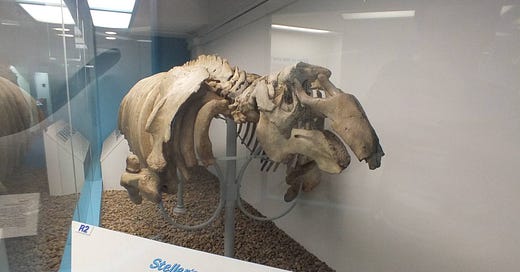'Where Are You, Steller's Sea Cow?'
Renewed interest in one of the world's most mysterious cryptids brought to mind this delightful letter concerning a sea cow sighting from the 1970s.
I was perhaps more excited than most when Forrest Galante, rediscoverer of lost animals and one of my favourite people on the planet, talked up the possibility that the Steller’s sea cow might still be with us.
Formerly extinct since the late 1700s, the sea cow was a close relation of the dugong, albeit one that was the size of a biggish whale. It’s a mammal I’ve been interested in ever since seeing the skeleton pictured above at the Natural History Museum in a dim and distant age known as the 1970s.
While checking out Forrest’s recent YouTube post, I was reminded of the following letter which appeared in Arthur C Clarke’s Chronicles Of The Strange And Mysterious, a book sequel to the author’s acclaimed TV series Mysterious World and World Of Strange Powers. I’ll allow the great man himself to introduce the missive which concerns a sea cow sighting from the 1970s:
I am grateful to Michel Raynal of Narbonne, France, for an item about the possible survival of Steller’s sea cow. The translation is so delightful that it would be a pity to correct it!:
“You know…” told me once Ivan Nikiforovich Chechulin, projectionist of the Karaginskaya culture and propaganda team - “… in summer 1976, I took part in some operations during the salmon fishing season in the Anapkinskaya Bay. A team of sealers of the collective farm ‘Tumgutum’ consisted of the local popular namely koryaks and Olutorsky Gulf inhabitants. Everybody took part in the fishery from their childhood.
“Once, just after a heavy storm, we noticed an unknown animal on a tidal belt. Its skin was dark, its tail was forked like that of the whale, the extremities of the animal were flippers. There were slightly noticed outlines of some round ribs. We approached the animal, touched it and were surprised as its head beared an unusual form and its snout was long. None of us has ever seen this animal.”
“Perhaps it was a small seal or a bearded steal, or a Steller’s sea lion,” asked me, half-serious, half in joke… Chechulin felt hurt. “Every one of us took part in the sealing a hundred times. Small seal’s blubber called by the local populations ‘nymilan’ is the best seasoning to ‘yukola’ (the local word for the dried and cured salmon) and ‘tolkusha’ (also a local word). All marine animals are known to us.”
I showed several drawings of the Steller’s sea cow to Ivan Nikiforovich. The animal, whose description was firstly given in 1741, was found off the Commander Islands by an eminent naturalist George Wilhelm Steller. Presently, this animal, the sea cow, bears the name of the Steller’s sea cow. “Just the same thing”, said IN Chechulin, examining the picture. “The same tail, the fore flippers and the head… Aren’t they left now?” he asked surprised. “Not a single one,” answered me, “although, in 1966,
a Museum of local lore was created in an Ustpakhachinskaya school.”
TINRO scientists became interested in two school exhibits.. the bones of some marine animals. Later on, the scientists published the results of their investigations in a newspaper, Kamchatskaya Pravda, where they paid their attention to the fact that one of those bones appeared to be a bone of a sea cow [that] died about 10 years ago.
For the present, the facts testify to another thing. The Steller’s sea cow was fired out by hunters throughout a short term. Inhabiting lagoons in the ashore waters where it fed on algae and ell grass, the Steller’s sea cow was a relic and dying animal.
Presently, the skull of the Steller’s sea cow is exposed in our Museum. A complete skeleton is kept in Khabarovsk Museum of local lore.
Kamchatka is studied insufficiently in biological and geographical aspects. There can be founds hundreds of areas in our country seldom visited by people and where marine mammals can inhabit easily including the Steller’s sea cow. These areas are lagoons, estuaries, lakes with warm water open to the sea.
The opinion of the scientists cannot be considered as a stable one for always. Let it be yet considered that the Steller’s sea cow has died out. But… to prove it finally, it is necessary to organise a special expedition.
There is need to organise a great biological expedition which could start its work in the summer months of 1977 throughout all regions of the Kamchatka with application of the method elaborated by the scientists of the Kamchatka Branch of TINRO.
Undoubtedly, the youth of our area will take an active part in these investigations.
VLADIMIR MALUKOVICH
Senior Scientific Worker
Kamchatka Museum Of Local Lore




